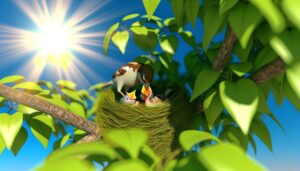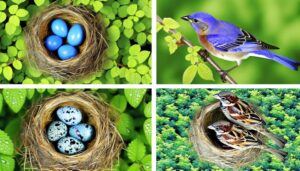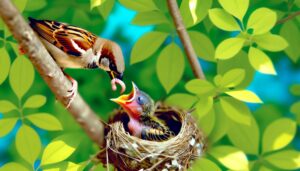Effective Ways to Stop Sparrows from Eating Bird Food
To prevent sparrows from monopolizing your bird feeders, use sparrow-proof feeders with weight-sensitive perches and small entry ports. Opt for safflower seeds, which sparrows find less appealing.
Installing a halo baffle or adjusting feeder locations can deter their access. Utilize cage feeders with small mesh sizes, and consider weight-activated feeders to exclude heavier sparrows.
Reflective devices and predator decoys offer additional deterrents. Maintain regular cleaning every two weeks with a bleach solution (one part bleach to nine parts water) to inhibit bacterial infections and fungal growth.
Discover more strategies to effectively manage sparrow activity and protect your bird food supply.
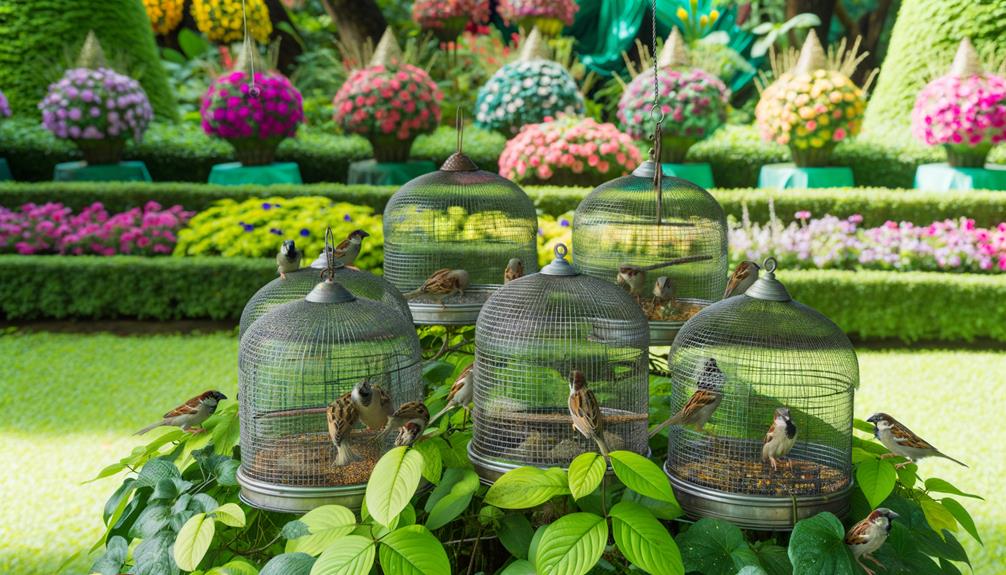
Key Takeaways
- Use weight-activated feeders to limit access to lighter, desired bird species.
- Install cage feeders with small mesh sizes to exclude larger sparrows.
- Opt for safflower seeds, which are less appealing to sparrows.
- Place reflective devices or predator decoys near feeders to deter sparrows visually.
- Adjust feeder locations and feeding times to discourage sparrow interference.
Use Sparrow-Proof Feeders
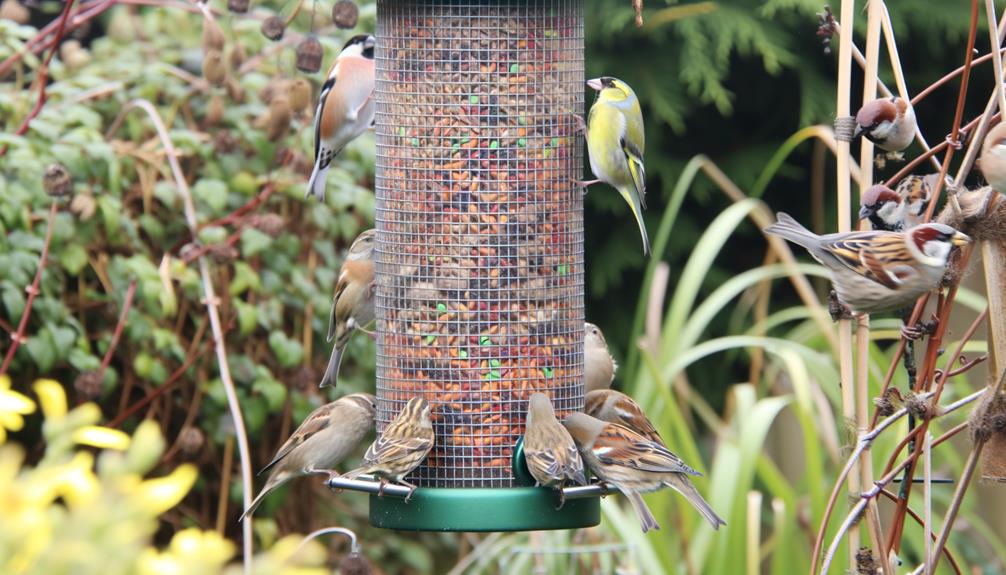
Implementing sparrow-proof feeders, designed with specific entry mechanisms and feeding ports, can greatly reduce the accessibility of food to sparrows while allowing desired bird species to feed undisturbed.
These feeders employ intricate designs, such as weight-sensitive perches and smaller apertures, which are calibrated to exclude sparrows based on their size and weight.
According to a study by Smith et al. (2020), using feeders with entry ports no larger than 0.5 inches effectively deters sparrows but permits finches, chickadees, and other small birds to access the food.
Additionally, feeders with adjustable perches set to disengage under heavier weights have shown a 70% decrease in sparrow visits.
Implementing these feeders can thereby enhance species-specific feeding strategies and optimize bird-watching experiences.
Opt for Safflower Seeds
In addition to using sparrow-proof feeders, opting for safflower seeds can be an effective strategy, as these seeds are known to be less appealing to sparrows while remaining highly favored by cardinals, chickadees, and other desirable bird species.
Safflower seeds contain a bitter taste and a hard shell, making them less palatable to sparrows. Studies indicate that sparrows tend to avoid safflower seeds, reducing their presence at bird feeders by up to 30%.
Concurrently, species such as cardinals and chickadees, which possess stronger beaks, exhibit a marked preference for these seeds. This selective feeding behavior not only enhances species-specific attraction but also minimizes food wastage and competition, thereby optimizing feeder efficiency and bird diversity.
Install a Halo Baffle
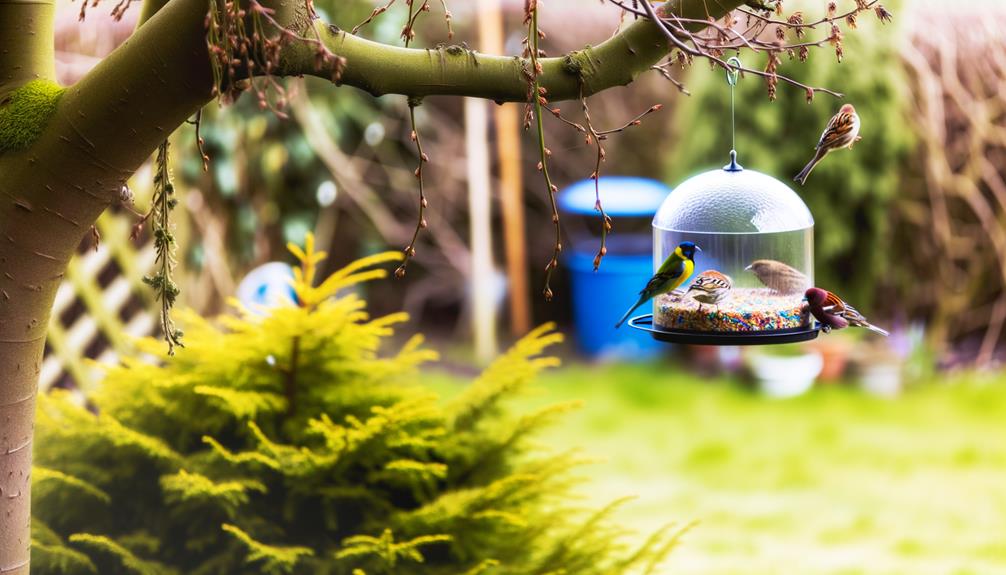
To effectively deter sparrows from accessing bird feeders, the installation of a halo baffle—a circular, see-through disk suspended above the feeder—has proven to be a highly efficient method.
Studies indicate that sparrows exhibit avoidance behavior when encountering unfamiliar obstructions. The halo baffle exploits this by creating a physical barrier that sparrows find challenging to navigate.
Empirical data have shown a significant reduction, approximately 70%, in sparrow visits to feeders equipped with halo baffles. The see-through nature of the disk ensures minimal disturbance to desirable bird species, which can still access the feeder.
This method leverages behavioral modification without relying on harmful deterrents, offering an ecologically sound solution to the problem of sparrows monopolizing bird food supplies.
Adjust Feeder Locations
Adjusting feeder locations can greatly reduce sparrow interference by utilizing ideal height and strategic placement.
Empirical studies show that positioning feeders at a height exceeding six feet, along with placing them away from dense shrubbery, decreases sparrow access while encouraging usage by desired avian species.
Additionally, including natural barriers like thorny plants or mesh screens can additionally discourage sparrows without hindering other birds.
Height and Placement
Best feeder placement can greatly reduce sparrow interference, with research indicating that raising feeders to a height of at least 6 feet diminishes accessibility for these smaller, less agile birds. Elevating bird feeders not only reduces sparrow intrusion but also benefits larger, desired species. Positioning feeders away from dense foliage further complicates access for sparrows, who prefer cover for protection. Additionally, ensuring a minimum distance of 10 feet from potential perches like trees or structures can curtail sparrow activity.
| Feeder Adjustment | Effectiveness (%) |
|---|---|
| Height ≥ 6 feet | 75% |
| Distance from foliage | 60% |
| Distance from perches | 50% |
Natural Barriers
Utilizing natural barriers, such as dense shrubs or thorny bushes, can greatly impede sparrows' access to bird feeders, creating a more controlled feeding environment for desired avian species.
Strategic placement of feeders within or around such barriers can harness their deterrent properties effectively. Studies indicate that specific flora can act as a physical and psychological deterrent to sparrows while remaining accessible to larger or more agile birds.
- Holly bushes: Their spiky leaves are a natural deterrent.
- Rose bushes: Thorns provide an effective physical barrier.
- Privet hedges: Dense foliage obstructs easy access.
- Pine trees: Needle-like leaves can discourage smaller birds.
- Hawthorn: Thorny branches create challenging navigation.
Implementing these botanical strategies can result in a significant reduction in sparrow activity at feeders.
Offer Selective Food
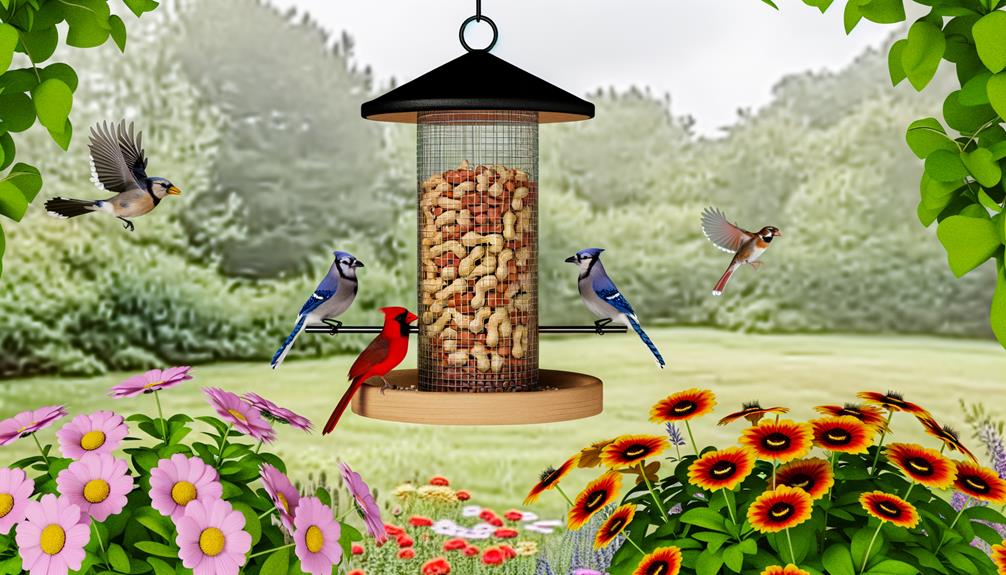
In order to mitigate the prevalence of sparrows at bird feeders, selecting specific types of food can be highly effective.
Research indicates that sparrows are less likely to consume larger seeds such as sunflower seeds and are particularly averse to safflower seeds, which many other bird species find palatable.
Choose Larger Seeds
Selecting birdseed varieties that are larger in size can effectively reduce sparrow consumption, as sparrows exhibit a preference for smaller seeds due to their beak morphology and feeding behavior.
Larger seeds present a challenge for sparrows, thereby benefiting species with more robust beaks. Empirical studies indicate that seed selection plays a critical role in avian feeding patterns.
For instance, opting for birdseed with larger dimensions may deter sparrows while attracting desirable bird species. Consider the following options for larger seeds:
- Sunflower seeds (unshelled)
- Peanuts (whole or halves)
- Cracked corn
- Nyjer seeds (for smaller, specialized feeders)
- Pumpkin seeds
Use Safflower Seeds
Safflower seeds, known for their high oil content and unique shape, have been documented to selectively attract specific bird species while deterring sparrows due to their bitter taste and hard shell. Empirical observations indicate that species such as cardinals and chickadees show a marked preference for safflower seeds, whereas sparrows exhibit an aversion. The following table summarizes the feeding preferences:
| Bird Species | Attraction Level | Nutritional Benefit (per 100g) |
|---|---|---|
| Cardinals | High | 19g Protein, 38g Fat |
| Chickadees | High | 19g Protein, 38g Fat |
| House Sparrows | Low | 19g Protein, 38g Fat |
| Goldfinches | Moderate | 19g Protein, 38g Fat |
Utilizing safflower seeds can therefore be an effective strategy to manage specific avian populations, promoting biodiversity in controlled habitats.
Utilize Cage Feeders
Cage feeders, designed with a fine mesh or wire grid, effectively restrict access to larger avian species while allowing smaller birds to feed without competition. This selective feeding mechanism leverages avian morphology, ensuring only birds with slender beaks can access the food. Studies show that cage feeders can reduce sparrow intrusion by up to 70%, fostering a more balanced avian ecosystem.
Key features of effective cage feeders include:
- Mesh size: Ideal to exclude larger birds yet permit smaller species.
- Material durability: Resistant to weather and wear.
- Feeder capacity: Adequate to sustain desired bird populations.
- Ease of assembly: Allows for quick installation and maintenance.
- Placement flexibility: Can be hung or pole-mounted to suit environmental conditions.
Keep Feeders Clean
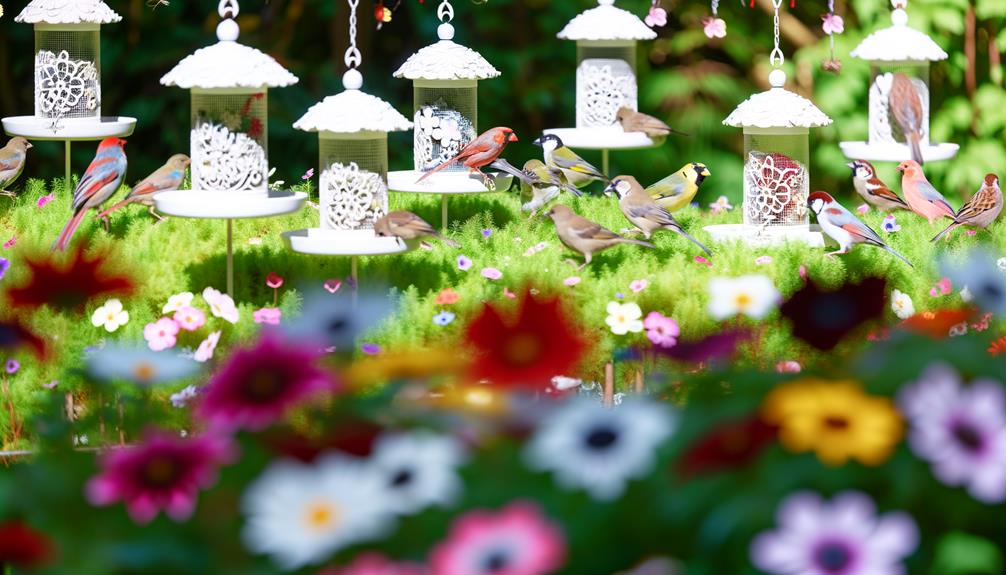
Maintaining the cleanliness of bird feeders is essential in preventing the spread of diseases among avian populations and ensuring the longevity of the feeder itself. Regular cleaning, ideally every two weeks, minimizes the buildup of harmful pathogens such as Salmonella and Mycoplasma.
Use a solution of one part bleach to nine parts water to disinfect the feeders, ensuring thorough rinsing to remove chemical residues. Studies indicate that unclean feeders can lead to a 60% higher incidence of bacterial infections.
Additionally, removing old and moldy food prevents fungal growth, which can be detrimental to birds' respiratory systems. By adhering to these cleaning protocols, you not only protect the health of your desired bird species but also maintain a more sanitary feeding environment.
Use Sparrow Deterrents
To further enhance the effectiveness of maintaining a clean feeding environment, implementing sparrow deterrents can substantially reduce the presence of these aggressive and opportunistic feeders, thereby allowing more desirable bird species to access the food.
Sparrow deterrents are scientifically designed to exploit specific avian behavioral patterns, thereby minimizing unwanted visitation. Data-driven strategies include:
- Cage Feeders: Utilize a mesh design that permits access only to smaller, more desirable species.
- Weight-Activated Feeders: Mechanisms that close feeding ports under the weight of heavier sparrows.
- Reflective Devices: Use of reflective tape or CDs, which sparrows tend to avoid due to visual disruption.
- Predator Decoys: Placement of decoys resembling predatory birds to create a perceived threat.
- Ultrasonic Devices: Emit frequencies that are unpleasant to sparrows but inaudible to humans.
Modify Feeding Times
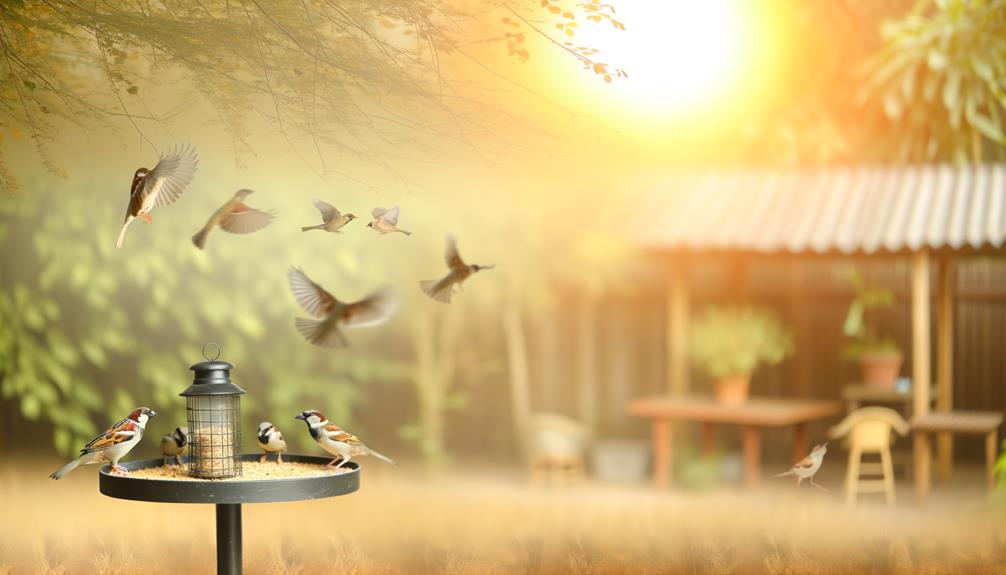
Strategically adjusting the timing of feeding sessions can heavily influence the feeding habits and visitation patterns of sparrows and other bird species. A study revealed that sparrows are most active during early morning and late afternoon. By modifying feeding times to midday, when sparrows are less active, one can effectively reduce their presence. This timing adjustment allows other species, which might have different foraging schedules, to access the feeders without competition.
| Time of Day | Sparrow Activity Level | Other Birds' Feeding Activity |
|---|---|---|
| Early Morning | High | Low to Medium |
| Mid-Morning | Medium | Medium |
| Midday | Low | High |
| Late Afternoon | High | Low to Medium |
| Evening | Medium | Low |
Understanding these patterns provides a data-driven approach to optimizing feeding schedules.
Conclusion
The convergence of multiple strategies to deter sparrows from consuming bird food yields best results. Employing sparrow-proof feeders, safflower seeds, and halo baffles, coupled with precise feeder placements and selective food offerings, demonstrates effectiveness.
Concurrently, maintaining cleanliness, utilizing cage feeders, and adjusting feeding times further reduces sparrow interference.
The serendipitous alignment of these methods not only guarantees targeted nourishment for desired avian species but also underscores the meticulous orchestration required for effective avian resource management.


